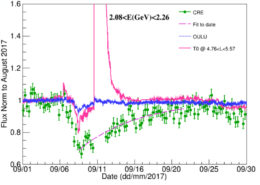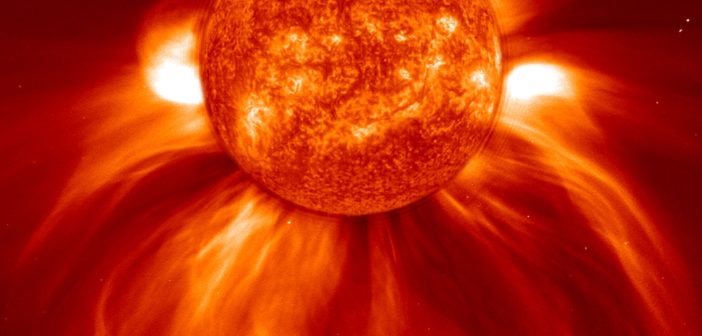What happens when high-energy particles from hundreds of light-years away enter our solar system? Today’s article details a clash between galactic cosmic rays and explosions of solar plasma.
A Journey Through the Solar System

Artist’s impression of the shower of particles caused when a cosmic ray, a charged particle produced by an astrophysical source, hits Earth’s upper atmosphere. [J. Yang/NSF]
Scientists have observed sudden decreases in the cosmic-ray flux when magnetized plasma explodes from the Sun’s upper atmosphere in a coronal mass ejection. These decreases in the cosmic-ray flux — dubbed Forbush decreases after the scientist who discovered them — may help us understand how galactic cosmic rays navigate the maze of magnetic fields in our solar system. Up until now, scientists have mostly used ground-based detectors to observe these interactions indirectly, but a new study has turned to an unlikely sounding spacecraft for help: the Dark Matter Particle Explorer.

Example of a Forbush decrease observed by DAMPE. The 2.08–2.26-GeV cosmic-ray flux (green) decreases while the total number of particles, including energetic particles from the Sun (magenta), increases. A fit to the data is shown in the dashed purple line. The blue symbols show data from a ground-based detector. [Adapted from Alemanno et al. 2021]
Not Just for Dark Matter
The Dark Matter Particle Explorer (DAMPE) was designed to detect high-energy particles and photons that might be produced when dark matter particles decay. From its vantage point in orbit around Earth, it can detect particles with a wide range of energies, making it a great tool for studying Forbush decreases.
The DAMPE collaboration selected data from September 2017, one of the most active periods of the previous solar activity cycle. The team monitored the flux of particles over time, separating the galactic cosmic rays from the particles originating from the Sun. They identified several particle events, consisting of a jump in the number of particles from the Sun coupled with the characteristic sharp dip and slow rise of a Forbush decrease in the cosmic-ray flux.
Deciphering Forbush Decreases

Forbush decreases observed by DAMPE at different energies. The solid lines show the model fits. Click to enlarge. [Alemanno et al. 2021]
The authors also highlighted the benefits of using DAMPE rather than ground-based detectors. In addition to the improved energy resolution, DAMPE was able to identify small particle events that went unnoticed by ground-based detectors. Hopefully, DAMPE will continue to help us understand how cosmic rays travel through our solar system for many years to come (in addition to detecting dark matter, of course!).
Citation
“Observations of Forbush Decreases of Cosmic-Ray Electrons and Positrons with the Dark Matter Particle Explorer,” Francesca Alemanno et al 2021 ApJL 920 L43. doi:10.3847/2041-8213/ac2de6
